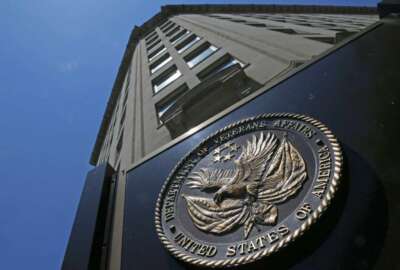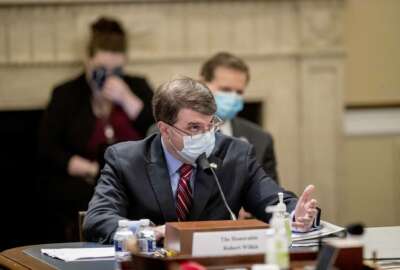

The Department of Veterans Affairs said it needs a six-month supply of personal protective equipment and other medical supplies to adequately handle a second wave...
If a second wave of the coronavirus pandemic hit tomorrow, the Department of Veterans Affairs wouldn’t have enough personal protective equipment stockpiled to adequately handle another surge.
As the largest integrated health care system in the country, VA has been competing for medical supplies just like everyone else during this pandemic. But many manufacturers haven’t been able to keep up with global demand, and VA can’t depend on these manufacturers and suppliers to keep shelves stocked during the health crisis, department officials said.
VA currently has a 30-day supply of personal protective equipment, but it’s not enough to safely support a resurgence of the virus down the road, Richard Stone, executive-in-charge of the Veterans Health Administration, told the Senate VA committee Tuesday afternoon.
“We need to move to a 60-day supply,” he said. “For a full second wave, we’ll need an additional six months of supply. Either that can be supplied by the vendors or must be in our readiness centers.”
“So Dr. Stone, we’re not where we need to be?” said Sen. Jon Tester (D-Mont.), the committee’s ranking member.
“That is correct,” Stone said.
To better prepare for whatever comes next with the pandemic, VA is planning to establish four “regional readiness centers” around the country where it can collect and store medical supplies, PPE and other equipment.
“We are working with our partners at the Defense Department, FEMA and the Department of Health and Human Services and our commercial partners to get the material to build up and to sustain the operations that we currently have today,” said Deborah Kramer, VHA’s acting undersecretary for health for support services. “But what I need to share with you is that the supply chain system is still broken. There is still a tremendous demand [for] PPE, not just in the United States but worldwide. The manufacturing system has not caught up to the requirement.”
At the height of the pandemic, VA consumed 250,000 N95 masks a day, Stone said. The department spent $10 million per month on personal protective equipment (PPE) a month before the pandemic began. But during the current health crisis, VA is buying $100 million in PPE each month.
No facility at VA ever ran out of protective equipment, though the guidelines on how many masks employees should receive and how often they could reuse PPE changed throughout the course of the pandemic, Stone said.
He dismissed the idea that VA’s approach to PPE and testing have put employees in danger.
To date, 34 employees have died due to complications from the virus, according to VA public data.
“My number one responsibility is the safety of veterans and the safety of employees who have pledged their work lives to the VA. It is impossible for any of us to understand how these employees got this disease,” Stone said. “To suggest that somehow we have endangered our personnel is just not borne out by the facts.”
The department is evaluating every employee death, and the Occupational Safety and Health Administration is involved in those investigations as well, Stone added.
VA last week admitted it “wasn’t there yet” in its efforts to provide on-demand coronavirus testing for its employees, again, due to a lack of swabs, cartridges and other supplies needed to process those tests.
VHA has tested 17% of its workforce to date, and it’s testing 600-to-700 employees a day, Stone said.
With only a few manufacturers making swabs in the entire world, VA is turning to its own 3D printing network for help. The department has been making “a few thousand” swabs a week, but it has a plan in place to begin making “about 100,000” swabs a week by this fall, Stone said.
Stone also clarified VA’s relationship and coordination with FEMA for supplies.
“At no time did FEMA take our supplies,” he said. “There was a short period of time immediately after the activation of the Defense Production Act, that every vendor and supplier in this nation paused delivery of some materials to await further guidance. As a result, there was a single week where we simply were not receiving supply orders. Therefore we deployed measures to ensure our employees had the PPE needed to be safe.”
To better involvement and perhaps improve collaboration between the department and other federal agencies, both Tester and Sen. Jerry Moran (R-Kan.), the committee’s chairman, are urging the president to include VA on the Defense Production Act committee.
“The federal government must ensure that the VA can continue to provide this care, starting with providing the VA with the means to ensure its medical facilities are stocked, and staff is appropriately equipped,” the senators wrote in a letter to president earlier this week.
Longstanding supply chain management challenges at VA are only complicating the department’s efforts to manage medical supplies during the pandemic.
Currently, VA supply technicians must switch back and forth between a few separate systems to view current inventory and then make purchases.
“A large percentage of our purchases are done locally at medical centers using government purchase cards with literally billions of dollars traversing those government purchase cards,” Stone said. “It’s very difficult for us to track those, as well as to track the contracts that are being used and to assure the validity and transparency of the system that you expect.”
Local VA medical facilities often make purchases based on what’s best for them, not for the entire VHA enterprise, said Kurt Heyssel, a former VHA chief supply chain officer.
“Often times the left hand doesn’t know what the right hand is doing,” he said. “VA corporate is not in control, as it must be, to achieve supply chain success.”
During the pandemic, VHA developed a makeshift, centralized system where all 170 medical centers could manually report on their supply. But senators were skeptical such a system could truly support such a large health care enterprise during a public health crisis.
Adopting the Defense Medical Logistics Standard Support (DMLSS), which has been the plan, should resolve many of VA’s challenges.
But implementation will take seven years, though the pandemic has proven VA needs to move faster, the department acknowledged.
The initial DMLSS roll-out at a VA facility near Chicago is scheduled for August. Two other sites in the Pacific Northwest will go live in the fall, Kramer said.
“Five years is perhaps possible, but we have to talk to our Department of Defense colleagues,” she said. “They are on the critical path to getting this system fielded. We cannot do it without their support, and we need to understand what their constraints are before we can actually tell you what a realistic schedule will be.”
Meantime, DoD is developing the next iteration of DMLSS, called LogiCole, which will move the current system to a cloud-based platform.
LogiCole is supposed to be ready in 2022, Stone said.
Copyright © 2025 Federal News Network. All rights reserved. This website is not intended for users located within the European Economic Area.
Nicole Ogrysko is a reporter for Federal News Network focusing on the federal workforce and federal pay and benefits.
Follow @nogryskoWFED



